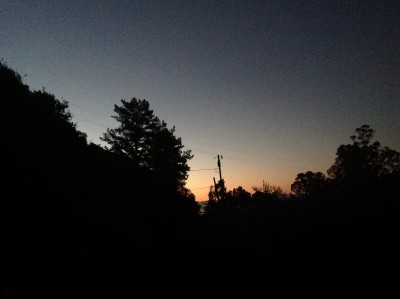
Well, if you wanna see the sun rise/ Honey, I know where
– Bob Dylan
Most mornings I watch the sun rise, taking the time with my baby daughter on my arm to point out the bands of color breathing life into the day over Monterey Bay, mouthing the word “sunrise” for her and naming as many colors as I can for her as she points and smiles. It strikes me that watching the sun rise is a great writing exercise.
If the color of the blank page or screen is white, then the color of a first draft is often black-and-white, like the view just before the first blush of predawn hues starts to tickle the birds into action; it takes learned patience to let the colors fill in, clear and true and right.
Somehow for me there was always a rushed, blurry feeling to taking in the sunrise – you’d been up all night, and there it was all of a sudden, and it made you think of bed or the future or a hundred other things. Or if you were up before sunrise, usually it was with some fixed task in mind and you were trying to get out the door or trying to get that chapter finished, or whatever, and any glimpses of the sunrise were quick, mental snapshots.
But with Coco I like to linger, and try to tune into the shifts of light from moment to moment, the subtle variation of air pressure and temperature, and wait for the colors to fill in like a coloring book left to its own devices. This turns out to be very much like what writing has become for me: It’s not about that first jagged slash of creation, fingertips bouncing on ASDF and JKL;, ready to fly, but about putting it out there, setting the scene for the real action to follow, as your thoughts or perceptions or recollections or imaginings deepen or morph into something other than what they were.
I find myself often thinking of what the German writer Günter Grass once said to me about how he could always spot books written on computers within a few pages, since it was all so quick; I see collections of words on the page that want to be writing, but have a data-dump quality to them, a tipping the basket over to let the contents spill out, without the crucial quality of letting the language distill or ferment and become something else. Time is the magic element. There has to be time to let the writing do its thing.
Here are a few tips on how to let the colors emerge in your writing, the fine shading and the delicate balance that makes all the difference:
- Less is more: A sunrise speaks to us in part because of its muted, understated palette of colors, a few variations on yellow and orange and red. To spend time with the sunrise is to tune into the beauty of a single shade, to love that shade and live in that shade and the sense of calm it brings. We need that singularity of focus in our writing as well.
- Look away: The beauty of a good sunrise can fill you up, to where the senses feel saturated, much as with passages of writing, so look away, blink, take a break, and come back fresh; a full and complete experience of sunrise can refresh you for a look on the page, and a full and complete experience of writing can refresh you for a look at another sunrise.
- Trust in time: Yes, as Andrew Marvell wrote back in the 17th-century in his fine, trying-to-get-a-woman-into-bed poem “To His Coy Mistress,” “But at my back I always hear/Time’s wingèd chariot hurrying near,” enough to give anyone the jitters, but the certainty that time will shape and shift us and our creations is also a comfort and a crucial tool, but only if we can find or fake a deeper devotion to patience. Watch and wait and the colors will come, maybe in seconds, maybe in months, but they will come.
– Steve Kettmann
Want to receive Steve’s blog on writers and writing every week by email? Sign up below.

